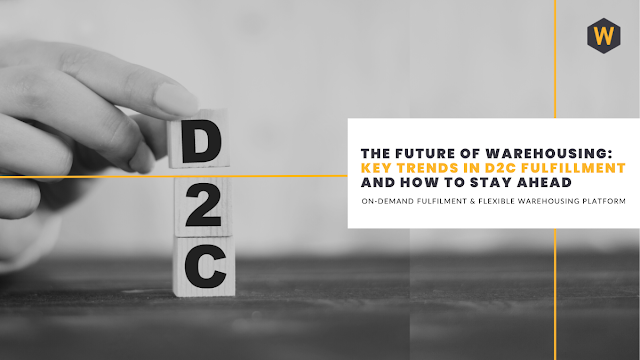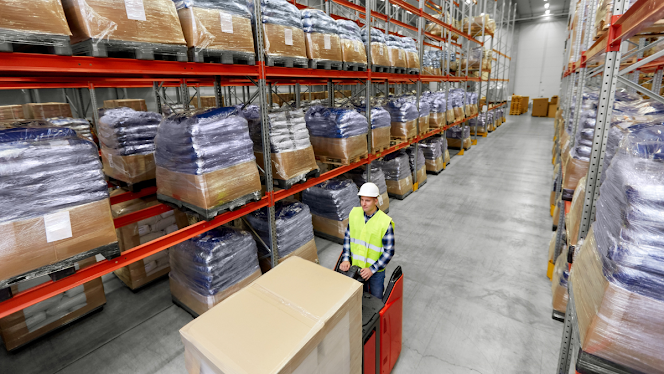The Future of Warehousing: Key Trends in D2C Fulfillment and How to Stay Ahead
In today's rapidly evolving business landscape, direct-to-consumer (D2C) fulfilment has emerged as a key strategy for companies to reach customers directly, bypassing traditional retail channels. As the e-commerce industry continues to grow, the future of warehousing plays a crucial role in enabling efficient D2C fulfilment. This article explores the key trends shaping the future of warehousing in D2C fulfilment and provides insights on how businesses can stay ahead.
Rise of D2C Fulfillment
2.1 Definition of D2C Fulfillment
D2C fulfilment refers to delivering products directly from the manufacturer or supplier to the end consumer, eliminating intermediaries such as retailers. It allows businesses to establish a closer relationship with customers, gain valuable insights, and deliver a seamless shopping experience.
2.2 Growth of D2C Fulfillment
The growth of D2C fulfillment can be attributed to various factors, including changing consumer preferences, advancements in technology, and the rise of social media and digital marketing. This shift empowers businesses to control their brand image, optimise the customer journey, and improve overall profitability.
Key Trends in D2C Fulfillment
3.1 Automation and Robotics
Automation and robotics are revolutionising the warehousing industry. With the adoption of robotic process automation (RPA) and automated guided vehicles (AGVs), businesses can streamline order picking, packing, and sorting processes. This enhances efficiency, reduces errors, and accelerates order fulfillment, improving customer satisfaction.
3.2 Data Analytics and AI
Data analytics and artificial intelligence (AI) enable businesses to gather and analyse vast amounts of data, leading to valuable insights. By leveraging predictive analytics, companies can optimise inventory management, demand forecasting, and supply chain operations. AI-powered chatbots also provide personalised customer support, enhancing the overall shopping experience.
3.3 Sustainable Practices
Sustainability is gaining prominence in the warehousing industry. Implementing eco-friendly practices such as energy-efficient lighting, waste reduction, and reusable packaging reduces the environmental impact and improves cost efficiency. Consumers are increasingly drawn to brands prioritising sustainable practices, making it a key trend in D2C fulfilment.
Enhancing Warehouse Efficiency
To stay ahead in the future of warehousing, businesses need to focus on enhancing warehouse efficiency. This involves optimising operations, including inventory management, order processing, and space utilisation.
4.1 Inventory Management
Effective inventory management is crucial for D2C fulfilment. By utilising advanced inventory tracking systems and real-time data analysis, businesses can ensure optimal stock levels, minimise stockouts, and reduce excess inventory. This leads to improved order fulfillment and cost savings.
4.2 Streamlined Order Processing
Efficient order processing is essential for meeting customer expectations. Implementing streamlined order processing systems, such as automated order routing and barcode scanning, enables faster and more accurate order fulfilment. This reduces processing time, minimises errors, and enhances overall operational efficiency.
4.3 Optimal Space Utilisation
With the increasing demand for D2C fulfilment, optimising warehouse space becomes crucial. Businesses can adopt vertical racking, dynamic slotting, and automated storage and retrieval systems to maximise storage capacity and minimise wasted space. This allows for efficient product organisation and smoother order-picking processes.
Importance of Seamless Integration
Seamless integration plays a vital role in the future of warehousing for D2C fulfilment. It involves integrating various systems, platforms, and partners to ensure smooth operations and a seamless customer experience.
5.1 Integrating E-commerce Platforms
Integrating e-commerce platforms with warehouse management systems (WMS) enables real-time inventory updates, order synchronisation, and seamless order routing. This integration streamlines the entire order fulfilment process, eliminates data discrepancies, and enhances customer satisfaction.
5.2 Integration with Logistics Providers
Collaboration with logistics providers is essential for efficient D2C fulfilment. Integrating warehouse systems with logistics partners' systems allows for seamless shipment tracking, accurate delivery estimates, and efficient transportation coordination. This integration ensures timely and reliable deliveries to customers.
Ensuring Customer Satisfaction
In the future of warehousing, prioritising customer satisfaction is paramount for success in D2C fulfilment. Meeting customer expectations and providing a delightful shopping experience can lead to customer loyalty and a positive brand reputation.
6.1 Faster and Accurate Deliveries
Prompt and accurate deliveries are critical in D2C fulfilment. Implementing efficient order fulfilment processes, leveraging technologies like route optimisation and real-time tracking, ensures faster and more reliable deliveries. This enhances customer satisfaction and builds trust in the brand.
6.2 Personalised Packaging
Personalised packaging adds a special touch to the customer's unboxing experience. Customising packaging with branding elements, personal messages, or tailored offers creates a memorable impression. It fosters a connection with the brand and enhances the overall shopping experience.
6.3 Efficient Returns Management
Efficient returns management is vital for customer satisfaction in D2C fulfilment. By implementing streamlined returns processes, including pre-authorisation, easy return labels, and hassle-free refund procedures, businesses can ensure customers a smooth and satisfactory return experience. This builds trust and encourages repeat purchases.
Challenges and Solutions
While the future of warehousing in D2C fulfilment offers immense opportunities, it also presents challenges that businesses need to overcome.
7.1 Scalability and Flexibility
As businesses grow, scalability and flexibility become critical factors. Adopting scalable warehouse solutions, utilising cloud-based WMS, and implementing flexible storage and picking systems enable businesses to adapt to changing demands and accommodate future growth.
7.2 Cybersecurity
Cybersecurity has become a significant concern with the increasing digitisation of warehousing operations. Implementing robust cybersecurity measures, including data encryption, regular system audits, and employee training, helps protect sensitive customer data and prevent potential cyber threats. This ensures the security and integrity of customer information, building trust and confidence in the brand.
Conclusion
The future of warehousing in D2C fulfilment is driven by key trends prioritising efficiency, integration, and customer satisfaction. Automation, data analytics, and sustainability are reshaping the industry, enabling businesses to optimise operations and deliver exceptional customer experiences with 4PL Partner Warehousity. By enhancing warehouse efficiency, seamlessly integrating systems and partners, and prioritising customer satisfaction, businesses can stay ahead in the evolving landscape of D2C fulfilment.
FAQs
Q: What is D2C fulfilment?
A: D2C fulfilment refers to delivering products directly from the manufacturer or supplier to the end consumer, bypassing traditional retail channels.
Q: How can automation and robotics improve D2C fulfilment?
A: Automation and robotics streamline order processing, reduce errors, and accelerate order fulfilment, resulting in improved efficiency and customer satisfaction.
Q: Why is seamless integration important in warehousing for D2C fulfilment?
A: Seamless integration ensures smooth operations, real-time data synchronisation, and a seamless customer experience, leading to enhanced efficiency and customer satisfaction.
Q: How can businesses ensure customer satisfaction in D2C fulfilment?
A: By focusing on faster and more accurate deliveries, personalised packaging, and efficient returns management, businesses can meet customer expectations and create a positive shopping experience.
Q: What are the key challenges in warehousing for D2C fulfilment?
A: Scalability, flexibility, and cybersecurity are key challenges that businesses need to address to stay ahead in the future of warehousing.
Related Links:



Struggling with your Application of Z-test Assignment? BookMyEssay provides top-notch Application of Z-test Assignment Help, ensuring clear explanations and impeccable support. Achieve academic excellence by getting professional assistance today swiftly.
ReplyDelete